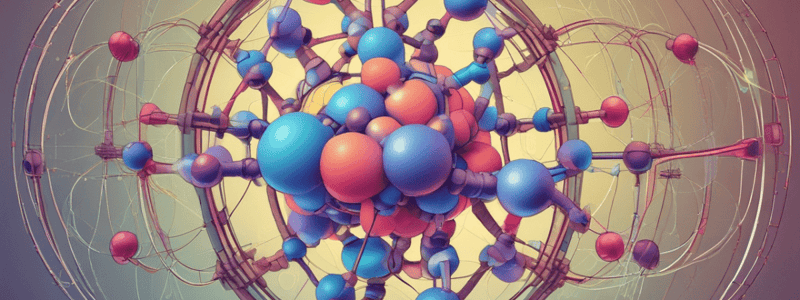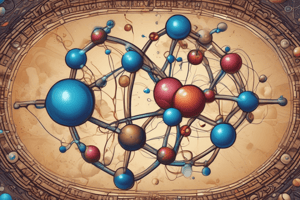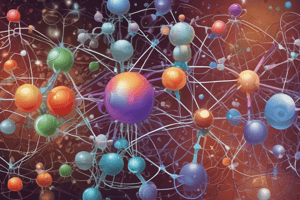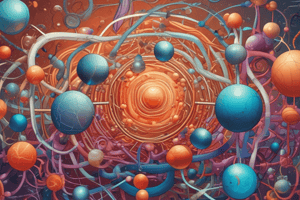Podcast
Questions and Answers
What is the state of matter where particles are closely packed in a fixed arrangement and can only vibrate in place?
What is the state of matter where particles are closely packed in a fixed arrangement and can only vibrate in place?
- Solid (correct)
- Gas
- Liquid
- Plasma
What is the process where a liquid becomes a gas?
What is the process where a liquid becomes a gas?
- Freezing
- Evaporation (correct)
- Melting
- Condensation
What is the temperature at which a solid becomes a liquid?
What is the temperature at which a solid becomes a liquid?
- Boiling Point
- Freezing Point
- Melting Point (correct)
- Sublimation Point
What is the movement of particles from an area of high concentration to an area of low concentration?
What is the movement of particles from an area of high concentration to an area of low concentration?
What is the state of matter where particles are far apart and move freely?
What is the state of matter where particles are far apart and move freely?
What is the process where a solid becomes a gas without passing through the liquid state?
What is the process where a solid becomes a gas without passing through the liquid state?
What is the process where a gas becomes a liquid?
What is the process where a gas becomes a liquid?
What is the process where a liquid becomes a solid?
What is the process where a liquid becomes a solid?
What is the process called when a liquid becomes a solid?
What is the process called when a liquid becomes a solid?
What happens to particles during the freezing process?
What happens to particles during the freezing process?
What is the boiling point?
What is the boiling point?
What occurs when a gas becomes a liquid upon cooling?
What occurs when a gas becomes a liquid upon cooling?
What is the process called when a solid transitions directly into a gas?
What is the process called when a solid transitions directly into a gas?
What is the reverse of sublimation?
What is the reverse of sublimation?
What is the main cause of Brownian motion?
What is the main cause of Brownian motion?
What is the kinetic molecular theory mainly used to explain?
What is the kinetic molecular theory mainly used to explain?
What is the main characteristic of particles in a solid state?
What is the main characteristic of particles in a solid state?
What happens to particles in a solid when it is heated and transitions into a liquid?
What happens to particles in a solid when it is heated and transitions into a liquid?
What is the main characteristic of particles in a gaseous state?
What is the main characteristic of particles in a gaseous state?
What is the process called when a solid becomes a liquid as it absorbs heat?
What is the process called when a solid becomes a liquid as it absorbs heat?
According to the kinetic molecular theory, what is the main factor that determines the energy level of particles?
According to the kinetic molecular theory, what is the main factor that determines the energy level of particles?
What is the main reason why solids are incompressible and rigid?
What is the main reason why solids are incompressible and rigid?
What is the main characteristic of particles in a liquid state?
What is the main characteristic of particles in a liquid state?
What is the main difference between the kinetic molecular theory and other theories of matter?
What is the main difference between the kinetic molecular theory and other theories of matter?
Which of the following states of matter has a fixed shape and volume?
Which of the following states of matter has a fixed shape and volume?
What is the process called when a solid transitions directly into a gas without passing through the liquid state?
What is the process called when a solid transitions directly into a gas without passing through the liquid state?
Which of the following best describes the motion of particles in a liquid?
Which of the following best describes the motion of particles in a liquid?
What is the main characteristic of particles in a gas?
What is the main characteristic of particles in a gas?
What is the result of the process of diffusion?
What is the result of the process of diffusion?
Which of the following is an example of diffusion?
Which of the following is an example of diffusion?
What is the main factor that determines the energy level of particles in a state of matter?
What is the main factor that determines the energy level of particles in a state of matter?
Which of the following statements is true about the kinetic molecular theory?
Which of the following statements is true about the kinetic molecular theory?
What happens to particles during the process of evaporation?
What happens to particles during the process of evaporation?
What is the result of particles losing energy during condensation?
What is the result of particles losing energy during condensation?
What occurs during the process of sublimation?
What occurs during the process of sublimation?
What is the result of particles losing energy rapidly during deposition?
What is the result of particles losing energy rapidly during deposition?
What is the difference between the freezing and condensation processes?
What is the difference between the freezing and condensation processes?
What is the common characteristic of particles during the processes of freezing, condensation, and deposition?
What is the common characteristic of particles during the processes of freezing, condensation, and deposition?
What is the primary reason for the random motion of particles in a fluid, as observed by Robert Brown?
What is the primary reason for the random motion of particles in a fluid, as observed by Robert Brown?
What is the main concept that explains the existence of different phases of matter and their transitions?
What is the main concept that explains the existence of different phases of matter and their transitions?
What is the primary factor that determines the energy level of particles in a substance?
What is the primary factor that determines the energy level of particles in a substance?
What is the characteristic of particles in a solid state that makes them incompressible and rigid?
What is the characteristic of particles in a solid state that makes them incompressible and rigid?
What is the primary difference between the attractive forces between particles in a solid and a liquid?
What is the primary difference between the attractive forces between particles in a solid and a liquid?
What is the result of the high energy level of particles in a gas?
What is the result of the high energy level of particles in a gas?
What is the process where a solid becomes a liquid as it absorbs heat?
What is the process where a solid becomes a liquid as it absorbs heat?
What is the characteristic of particles in a liquid state that allows them to conform to the shape of their container?
What is the characteristic of particles in a liquid state that allows them to conform to the shape of their container?
What is the result of the increased energy level of particles during a phase transition from solid to liquid?
What is the result of the increased energy level of particles during a phase transition from solid to liquid?
What is the characteristic of particles in a solid state that results in their rigid structure?
What is the characteristic of particles in a solid state that results in their rigid structure?
What happens to the particles' energy during the process of condensation?
What happens to the particles' energy during the process of condensation?
Which process involves the transition from a solid to a gas without passing through the liquid state?
Which process involves the transition from a solid to a gas without passing through the liquid state?
What is the primary difference between the freezing and condensation processes?
What is the primary difference between the freezing and condensation processes?
During the process of deposition, what happens to the particles' energy?
During the process of deposition, what happens to the particles' energy?
What is the common characteristic of particles during the processes of freezing, condensation, and deposition?
What is the common characteristic of particles during the processes of freezing, condensation, and deposition?
What is the result of the particles' energy change during the process of evaporation?
What is the result of the particles' energy change during the process of evaporation?
What is the main difference between a liquid and a gas?
What is the main difference between a liquid and a gas?
What is the primary factor that determines the state of matter of a substance?
What is the primary factor that determines the state of matter of a substance?
What happens to the particles during a change of state from solid to liquid?
What happens to the particles during a change of state from solid to liquid?
What is the result of the process of diffusion?
What is the result of the process of diffusion?
What is the main characteristic of particles in a solid state that makes them incompressible and rigid?
What is the main characteristic of particles in a solid state that makes them incompressible and rigid?
What is the primary reason for the difference in the attractive forces between particles in a solid and a liquid?
What is the primary reason for the difference in the attractive forces between particles in a solid and a liquid?
What is the result of the high energy level of particles in a gas?
What is the result of the high energy level of particles in a gas?
What is the characteristic of particles in a liquid state that allows them to conform to the shape of their container?
What is the characteristic of particles in a liquid state that allows them to conform to the shape of their container?
What is the primary factor that determines the phase of a substance?
What is the primary factor that determines the phase of a substance?
Which of the following is a characteristic of particles in a liquid state?
Which of the following is a characteristic of particles in a liquid state?
What is the result of particles gaining energy during a phase transition from solid to liquid?
What is the result of particles gaining energy during a phase transition from solid to liquid?
What is the primary reason why gases are easily compressible?
What is the primary reason why gases are easily compressible?
According to the kinetic molecular theory, what is the main characteristic of particles in a gas?
According to the kinetic molecular theory, what is the main characteristic of particles in a gas?
What is the primary difference between the attractive forces between particles in a solid and a liquid?
What is the primary difference between the attractive forces between particles in a solid and a liquid?
What is the result of the kinetic molecular theory's explanation of the existence of different phases of matter?
What is the result of the kinetic molecular theory's explanation of the existence of different phases of matter?
What is the primary characteristic of particles in a solid state that makes them incompressible and rigid?
What is the primary characteristic of particles in a solid state that makes them incompressible and rigid?
What is the process that occurs when a solid becomes a liquid as it absorbs heat?
What is the process that occurs when a solid becomes a liquid as it absorbs heat?
What is the main concept that explains the random motion of particles in a fluid, as observed by Robert Brown?
What is the main concept that explains the random motion of particles in a fluid, as observed by Robert Brown?
What is the primary reason for the difference in the arrangement of particles in a solid, liquid, and gas?
What is the primary reason for the difference in the arrangement of particles in a solid, liquid, and gas?
Which process involves the transition from a liquid to a gas with the formation of bubbles?
Which process involves the transition from a liquid to a gas with the formation of bubbles?
What is the result of the increased energy level of particles during a phase transition from solid to liquid?
What is the result of the increased energy level of particles during a phase transition from solid to liquid?
What is the characteristic of particles in a gas that results in their ability to fill their container?
What is the characteristic of particles in a gas that results in their ability to fill their container?
What is the primary factor that determines the energy level of particles in a state of matter?
What is the primary factor that determines the energy level of particles in a state of matter?
What is the result of particles losing energy during condensation?
What is the result of particles losing energy during condensation?
What is the primary reason for the difference in the compressibility of solids, liquids, and gases?
What is the primary reason for the difference in the compressibility of solids, liquids, and gases?
What is the primary reason why particles arrange themselves into a fixed, orderly structure during freezing?
What is the primary reason why particles arrange themselves into a fixed, orderly structure during freezing?
What is the characteristic of particles in a liquid state that allows them to conform to the shape of their container?
What is the characteristic of particles in a liquid state that allows them to conform to the shape of their container?
What is the main difference between evaporation and boiling?
What is the main difference between evaporation and boiling?
During sublimation, what happens to the attractive forces between particles?
During sublimation, what happens to the attractive forces between particles?
What is the result of particles moving closer together during condensation?
What is the result of particles moving closer together during condensation?
What is the common characteristic of particles during the processes of sublimation and deposition?
What is the common characteristic of particles during the processes of sublimation and deposition?
What is the primary reason why deposition occurs rapidly?
What is the primary reason why deposition occurs rapidly?
What is the primary reason for the difference in the rigidity of solids and liquids?
What is the primary reason for the difference in the rigidity of solids and liquids?
How does the energy level of particles affect the movement of particles in a gas?
How does the energy level of particles affect the movement of particles in a gas?
What is the primary characteristic of the kinetic molecular theory that explains the existence of different phases of matter?
What is the primary characteristic of the kinetic molecular theory that explains the existence of different phases of matter?
What is the result of the increased energy level of particles during a phase transition from solid to liquid?
What is the result of the increased energy level of particles during a phase transition from solid to liquid?
What is the primary factor that determines the energy level of particles in a substance?
What is the primary factor that determines the energy level of particles in a substance?
What is the characteristic of particles in a solid state that results in their rigid structure?
What is the characteristic of particles in a solid state that results in their rigid structure?
What is the primary difference between the attractive forces between particles in a solid and a liquid?
What is the primary difference between the attractive forces between particles in a solid and a liquid?
How does the energy level of particles affect the arrangement of particles in a solid?
How does the energy level of particles affect the arrangement of particles in a solid?
What is the result of the high energy level of particles in a gas?
What is the result of the high energy level of particles in a gas?
What is the primary characteristic of the kinetic molecular theory that explains the transitions between different phases of matter?
What is the primary characteristic of the kinetic molecular theory that explains the transitions between different phases of matter?
What happens to the arrangement of particles during the freezing process?
What happens to the arrangement of particles during the freezing process?
What is the main difference between evaporation and boiling?
What is the main difference between evaporation and boiling?
What occurs when a gas transitions directly into a solid?
What occurs when a gas transitions directly into a solid?
What is the result of particles losing energy during condensation?
What is the result of particles losing energy during condensation?
What is the primary reason for the change of state from solid to liquid?
What is the primary reason for the change of state from solid to liquid?
What is the characteristic of particles in a liquid state that allows them to conform to the shape of their container?
What is the characteristic of particles in a liquid state that allows them to conform to the shape of their container?
What occurs during the process of sublimation?
What occurs during the process of sublimation?
What is the result of the increased energy level of particles during a phase transition from solid to liquid?
What is the result of the increased energy level of particles during a phase transition from solid to liquid?
What is the common characteristic of particles during the processes of freezing, condensation, and deposition?
What is the common characteristic of particles during the processes of freezing, condensation, and deposition?
What is the primary reason for the difference in boiling points between substances?
What is the primary reason for the difference in boiling points between substances?




